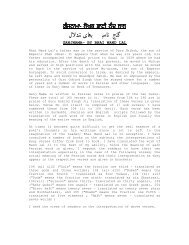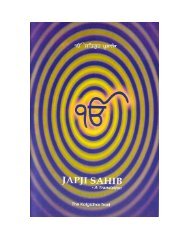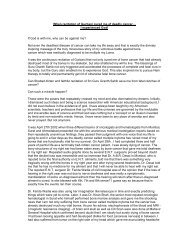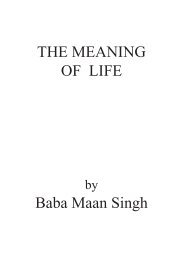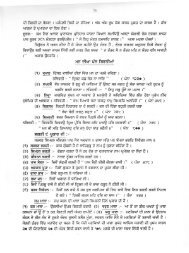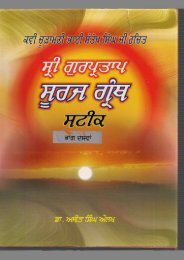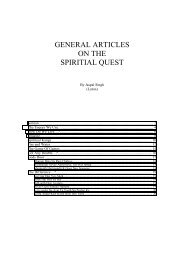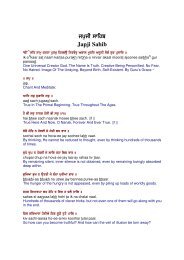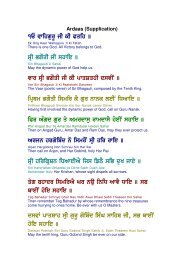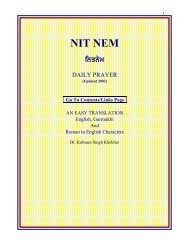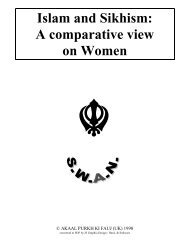OUTLINES OF SIKH DOCTRINES - Raj Karega Khalsa Network
OUTLINES OF SIKH DOCTRINES - Raj Karega Khalsa Network
OUTLINES OF SIKH DOCTRINES - Raj Karega Khalsa Network
You also want an ePaper? Increase the reach of your titles
YUMPU automatically turns print PDFs into web optimized ePapers that Google loves.
<strong>OUTLINES</strong> <strong>OF</strong> <strong>SIKH</strong> <strong>DOCTRINES</strong>By SANT TEJA SINGH
CHAPTER 1MISSION <strong>OF</strong> THE HUMAN LIFETHE NATURE <strong>OF</strong> GOD OR THE NAMECHAPTER 2UPLIFT <strong>OF</strong> MAN BASED ON CHARACTERCHAPTER 3THE GURU IN <strong>SIKH</strong>ISMTHE GURU IN THE <strong>SIKH</strong>THE GURU IN THE PANTHCHAPTER 4FORMS AND CEREMONIESTHE PATH FOR WORLD PEACEWHAT ARE THEY, HOLY OR IGNORANT?WEAPONS <strong>OF</strong> VIOLENCEPEACE IS HERE WITH US“ GOD, IN THY NAME BLESS THE WHOLE HUMANITY”
CHAPTER 1MISSION <strong>OF</strong> HUMAN LIFEThe aim of life, according to the Sikh Gurus, is not to get salvation or a heavenlyabode called Paradise, but to develop the best in us which is God.If a man loves to see God what cares he for Salvation or Paradise?“Everybody hankers after Salvation, Paradise or Elysium, setting their hopes onthem every day of their lives. But those who live to see God do not ask forSalvation: The sight itself satisfies their minds completely.”How to see God and to love Him? The question is taken up by Guru Nanak in hisJapji:What shall we offer to Him that we may behold His council chamber?What shall we utter with our lips, which may move Him to give His love?In the ambrosial hours of the morn meditate on the grace of the true Name;For, your good actions may procure for you a better birth, but emancipation isfrom Grace alone.We should worship the Name, believe in the Name, which is ever and ever thesame and true.The practice of the Name is prescribed again and again in the Sikh Scriptures,andrequires a little explanation.THE NATURE <strong>OF</strong> GOD OR THE NAME:God is described both as nirgun, or absolute, and sargun, or personal. Beforethere was any creation God lived absolutely in Himself, but when He thought ofmaking Himself manifest in creation He became related. In the former case,when God was Himself self-created, there was none else; He took counsel andadvice with Himself; what He did came to pass. Then there was no heaven, orhell, or three-regioned world. There was only the Formless One Himself; creationwas not then. There was then no sin, no virtue, no Veda or any other religiousbook, no caste, no sex.When God became sargun or manifest, he became what is called the Name, andin order to realize Himself He made nature where in He has His seat and isdiffused everywhere and in all direction in the form of Love.
In presenting this double phase of the Supreme Being, the Gurus have avoidedthe pitfalls into which some people have fallen. With them God is not an abstractidea or a moral force, but a personal Being capable of being loved and honored,and yet He is conceived of as a Being whose presence is diffused all over Hiscreation. He is the common father of all, fashioning worlds and supporting themfrom inside, but He does not take birth. He has no incarnations. He Himselfstands for the creative agencies, like the Maya, the World and Brahma; HeHimself is Truth, Beauty and the eternal yearning of the heart after Goodness(Japji). In a word, the Gurus have combined the Aryan idea of immanence withSemitic idea of transcendence, without taking away anything from the unity andthe personal character of God.O! give me, give some message of my Beloved.I am bewildered at the different accounts I have of Him.O happy devoted souls, my companions, say something of Him.Some say that He is altogether outside the world;Others say that He is altogether contained in it.His color is not seen; His features cannot be made out; O happy devoted soulstell me truly.He lives in everything; He dwells in every heart;Yet He is not blended with anything; He is separate.“Why dost thou go to the forest in search of God?He lives in all, is yet ever distinct; He abides with thee too. As fragrance dwells ina flower, or reflection in a mirror, So does God dwell inside everything; seek Himtherefore in the heart.People who come with preconceived notions to study Sikhism often blunder inoffering itsinterpretation. Those who are conversant with the eastern thoughts fix uponthose passages which refer to the thoughts of immanence and conclude thatSikhism is nothing but and echo Hinduism, while those who are imbued with theMohammedan or Christian thought take hold of transcendental passages andidentify Sikhism with Islam or Christianity. Others who know both will see here nosystem, nothing particular, nothing but confusion.If however, we were to study Sikhism as an organic growth evolved from theexisting systems of thought to meet the needs of a newly evolving humanity, wewould find no difficulty in recognizing Sikhism as a distinct system of thought.Take, for instance, Guru Nanak’s Asa-ki-Var, which in its preliminary stanzas laysdown the fundamentals of Sikh belief about God. it is a trenchant clear-cutmonotheism. God is called the in-dweller of Nature, and is described as filling allthings ‘by an art that is artless’. He is not an impotent mechanic fashioning pre-
existing matter into the universe. he does not exclude matter, but transcends it.The universe too is not an illusion. Being rooted in god who is real, it is a reality;not a reality final and abiding, but a reality on account of God’s presence in it. HisWill is above Nature as well as working within it, and in spite of its immanence itacts not as an arbitrary force but as a personal presence working mostintelligently.’ The first thing about God is that He is indivisibly one, above everyother being, however highly conceived, such as Vishnu, Brahma, or Shiva, or asRama and Krishna. The second thing is that He is the highest moral being, He isnot a God belonging to any particular people, Muslim or Hindu, but is ‘thedispenser of lifeuniversal’. The ways to realize Him are not many, but only one, and that way isnot knowledge, formalism, or what are received as meritorious actions whichestablish a claim to reward, but love and faith, the aim being to obtain the graceof God.The only way of worshiping Him is to sing His praises and to meditate on Hisname.CHAPTER 2UPLIFT <strong>OF</strong> MAN BASED ON CHARACTERThis life of praise is not to be of idle mysticism, but of active service done in themidst of wordly relations. “There can be no worship without good actions.” Theseactions, however, are not to be formal deeds of so-called merit, but should beinspired by an intense desire to please God and to serve fellow-men.“Without pleasing God all actions are worthless.Repetition of mantras, austerities, set ways of living, or deeds of merit leave usdestitute even before our journey ends.You won't get even half a copper for your fasts and special programmes of life.These things, O brother, won't do there: for the requirements of that way arequitedifferent.You won't get a place there for all your bathing and wandering in differentplaces.There means are useless’ they cannot satisfy the conditions of that world.Are you a reciter of all the four Vedas? There is no room for you there.With all your correct reading, if you don't understand one thing that matters, youonly bother yourself.Nanak says, if you exert yourself in action, you will be saved. Serve your Godand remember Him, leaving all your pride of self.
The Gurus laid the foundation of man’s uplift, not on such short-cuts as mantras,miracles or mysteries, but on man’s own humanity, his own characters alreadyformed which helps us in moral crises. Life is like a cavalry march. The officer ofa cavalry on march has to decide very quickly when to turn his men left or right.he cannot wait until his men are actually on the brink of a nulla or khud. He mustdecide long before that. In the same way, when face to face with an evil, we haveto decide quickly. Temptations allow us no time to think. They always comesuddenly. When offered a bribe or an insult, we have to decide at once whatcourse of action we are going to take. We cannot then consult a religious book ormoral guide. We must decide according to our impulse. And this can be doneonly if virtue has so entered into our disposition that we are habitually drawntowards it, and evil has got no attraction for us. Without securing virtuesufficiently in character, even some of the so-called great men have been knownto fallan easy prey to temptation. It was for this reason that for the formation ofcharacter the Gurus did not think it sufficient to lay down rules of conduct in abook; they also thought it necessary to take in hand a whole people for acontinuous course of schooling in wisdom and experience, spread over manygenerations, before they could be sure that the people thus trained had acquireda character of their own. This is the reason why in Sikhism there have been tenfounders, instead of only one.Before the Sikh Gurus, the leaders of thought had fixed certain grades ofsalvation, according to the different capacities of men, whom they divided intohigh and low castes. They development of character resulting from this was onesided.Certain people, belonging to the favored classes, got developed in them afew good qualities to a very high degree, while others left to themselves gotdegenerate. It was as if a gardener, neglecting to look after all the different kindsof plants entrusted to him, were to bestow all his care on a few chosen ones,which were in bloom, so that he might be able to supply a few flowers every dayfor his master’s table. The Gurus did not want to have such a lop-sided growth.They want to give opportunities of highest development to all the classes ofpeople.There are lowest men among the low castes.Nanak, I shall go with them. What have I got to do with the high castes?God’s eye of mercy falls on those who take care of the lowly.It is mere nonsense to observe caste and to feel proud over grand names.Some work had already been done in this line. The Bhagats or reformers in theMiddle Ages had to abolish the distinction between the high-caste Hindus andthe so-called untouchables, by taking into their fold such men as barbers,weavers, shoemakers, etc. But the snake of untouchability still remainedunscorched; because the privilege of equality was not extended to men as men,
ut to those individuals only who had washed off their untouchability with the loveof God. Kabir, a weaver, and Ravidas, a shoemaker, were honored by kings andhigh-caste men, but the same privilege was not extended to other weavers andshoemakers who were still held as untouchables. Ravidas took pride in the factthat the love of God has so lifted him out of his caste that even “the superior sortof Brahmins came to bow before him,” while the other members of his caste, whowere working as shoemakers in the suburbs of Ben ares, were not so honored.The Sikh Gurus made this improvement on the previous idea that they declaredthe whole humanity to be one and that a man was to be honored, not because hebelonged to this or that caste or creed, but because he was a man, an emanationfrom God, who had given him the same senses and the same soul as to othermen:Recognize all human nature as one.All men are the same, although they appear different under different influences,The bright and the dark, the ugly and the beautiful, the Hindus and the Muslims,have developed themselves according to the fashions of different countries.All have the same eyes, the same ears, the same body and the same build- acompound of the same four elements.Such a teaching could not tolerate any ideas of caste or untouchability. Man rosein the estimation of man. Even those who had been considering themselves asthe dregs of society and whose whole generations had lived as groveling slavesof the so-called higher classes, came to be fired with a new hope and courage tolift themselves as equals of the best humanity.Women too received their due. “How can they be called inferior,” says GuruNanak, “when they give birth to kings and prophets?” Women as well as menshare in the grace of God and are equally responsible for their actions to Him.Guru Hargobind called woman “the conscience of man.” Sati was condemned bythe Sikh Gurus long before any notice was taken of it by Akbar.The spirit of man was raised with a belief that he was not a helpless creature inthe hands of a Being of an arbitrary will of his own, with which he could do muchto mold his destiny. Man does not start his life with a blank character. he hasalready existed before he is born here. He inherits his own past as well as that ofhis family and race. All this goes to the making of his being and has a share inthe moulding of his nature. But this is not all. He is given a will with which he canmodify the inherited and acquired tendencies of his past and determine hiscoming conduct. If this were not so, he would not be responsible for his actions.This will, again, is not left helpless or isolated; but if through the Guru’s Word itbe attuned to the Supreme Will, it acquires a force with which he can transcend
all his past and acquire a new character. This question of humanwill as related to the Divine Will is an intricate one and requires a little elucidation.According to Sikhism, the ultimate source of all that is in us is God alone. WithoutHim there is no strength in us. Nobody, not even the evil man, can say that hecan do anything independent of God. Everyday moves within the Providentialdomain.Thou art a river in which all beings move:There is none but Thee around them.All living things are playing within Thee.The fish may run against the current of the river or along with it, just as it likes,but it cannot escape the river itself. Similarly man may run counter to what isreceived as good or moral, but he can never escape from the pale of God’s Will.Then who is responsible for his actions? Man himself. We learn from the firstshlok of Asa-ki-Var’s 7th pauri that man is given free will, which leads him to dogood or evil actions, to think good or evil thoughts and to go in consequence toHeaven or Hell:Governed by his free will he laughs or weeps:Of his free will he be grimes or washes himself;Of his free will he degrades himself from the order of human being:Of his his free will he befools himself or becomes wise.In the next shlok we read:Self-assertion gives man his individuality and leads him to action:It also ties him down to the world and sends him on a round of births and deaths.Wherefrom comes this assertion of self? How shall it leave us? It comes to manfrom the Will of God and determines his conduct according to his antecedents.It is an extremely harmful disease; but there is also remedy for it.When God sends grace to man, he begins to obey the call of the Guru.Nanak says; Hear ye all, this is the way to cure the disease.The source of evil is not Satan or Ahriman, or any other external agency. It is ourown sense of Ego placed by God in us. It may prove a boon or a curse to us,according as we subject ourselves to God’s Will or not. It is the overweeningsense of self that grows as a barrier between God and man and keeps himwandering from sin to sin-The Lord and the Consort live together, with a partition of Ego between them.
The infinite is within us, engraved in our being, like a cipher which is graduallyunfolding its meaning as we listen to the voice of the Teacher. It is like the light ofthe sun ever present, but shut out of our sight by the cloud of ignorance andselfishness. We sin as long as this light remains unmanifested and we believe inour own self as everything to us.Regeneration comes when, at the call of Grace, we begin to subject our tiny selfto the highest Self, that is God, and our own will is gradually attuned to HisSupreme Will, until we feel and move just as He wishes us to feel and move.Really the problem of good and evil is the problem of Union and Disunion withGod. All things are strung on God’s Will, and man among them. As long as manis conscious of this, he lives and moves in unions with Him. But gradually ledaway by the overweening sense of self he cuts himself away from that unity andbegins to wander in moral isolation. It is however, so designed in the case of manthat whenever he wishes he can come back to the bosom of his Father and Godand resume his position there. Guru Nanak says in Maru:By the force of Union we meet God and enjoy Him even with this body;And by the force of Disunion we break away from Him:But Nanak, it is possible to be united again.When we come into this world, we begin our life with a certain capital. We inheritour body from our parents, and there are divine things in us, as ‘the spirit andprogressive tendencies,’ which serve as forces of Union and keep us united withgod. But there are also evil tendencies in us inherited from our past lives whichserve as forces of Disunion and draw us away from Him towards moral death.Guru Nanak says in Maru:Man earns his body from the union of his mother and father;And the Creator inscribes His being with the gifts of the spirit and progressivetendencies.But led away by delusion he forgets himself.This teaching about the freedom of will and ‘progressive tendencies’ raises thespirit of man and gives him a new hope and courage. But that is not enough toenable him to resist evil and to persist in positive virtue. The temptation of evil isso strong and the human powers for resisting it-inspire of the inherentprogressive tendencies-are so weak that it is practically impossible for him tofulfill that standard of virtue which is expected of him. It was this consciousnessof human weakness which made Farid say:The Bride is so weak in herself, the Master so stern in His commands.That is, man is endowed with such weak faculties that he stumbles at each step,
and yet it is expected of him that He should always speak the truth, and never telllies.O ignorant man beware of sin.He should not step on the bed of another’s wife even in dream.These commands cannot be fulfilled simply with the strength of knowledge andinherited tendencies. They will not go far even in resisting evil. The higher idealof leading a life positive virtue and sacrifice is absolutely impossible with such aweak equipment. Then what is to be done?The prophets of the world have given many solutions of this problem. Some getaround the difficulty by supposing that there is no evil. It is only a whim or a falsescare produced by our ignorance. They believe in the efficacy of Knowledge.Others believe in the efficacy of Austerities; still others in Alms given in profusionto overwhelm the enormity of sin. There are, again, a higher sort of teachers whoinculcate the love of some great man as a Savior. What was the solution offeredby the Sikh Gurus?They saw that although it was difficult for a man to resist evil and to do good withhis own powers, yet if he were primed with another personality possessingdynamic, he could acquire a transcendental capacity for the purpose. Thispersonality was to be the Guru’s.CHAPTER 3THE GURU IN <strong>SIKH</strong>ISMThe way of religion, as shown by Sikhism, is not a set of views or doctrines, but away of life lived according to a definite model. It is based, not on rules or laws,but upon discipleship. In the career of the disciple the personality of the Guru isall along operative, commanding his whole being and shaping his life to itsdiviner issues. Without such a personality there would be no cohesion, nodirection in the moral forces of society, and in spite of a thousand kinds ofknowledge ‘there would still be utter darkness.’ There would be no force toconnect men with men and them with God. Everybody would exist for himself inmoral isolation, ‘like spurious sesame plants left desolate in the field with ahundred masters to own them.’ It is the Guru who removes the barriers of casteand position set up by men among themselves and gathering them all untohimself unites them with God. In the way foundations are laid of a society of thepurified who as an organized force strive for the good of the whole mankind.Such a creative personality must be perfect, because ‘men take after whom theyserve.’ If the ideal person is imperfect, the society and its individuals following
him will also get imperfect development. But ‘those who serve the saved oneswill be saved.’The Sikh Gurus were perfect, and are described as such in the Sikh Scriptures.Guru Nanak himself says in Sri Rag: “Everybody else is subject to error, only theGuru and God are free from error.” Guru Arjun says in Bhairon: “Whoever youmeet suffers from vices; without any defect is my true Guru, the Yogi.” The stateof perfection attained by the Gurus is lucidly described in the eighth and theeighteenth octaves of Guru Arjan’s Sukhmani.The same Guru says in Asa:God does not die, nor do I fear death,He does not perish, nor do I grieve.He is not poor, nor do I have hunger.He has no pain, nor have I any trouble.There is no destroyer but God,Who is my life and who gives me life.He has no bond, nor have I got any.He has no entanglement, nor have I any care.As He is happy, so am I always rejoicing.He has no anxiety, nor have I any concern.As He is not defiled, so am I not polluted.As He has no craving, so do I covet nothing.He is pure and I too suit Him in this.I am nothing: He alone is everything.All around is the same He.Nanak, the Guru has destroyed all my superstition and defects,And I have become uniformly one with Him.The Guru is sinless. In order, however, to be really effective in saving man, hemust not be above man’s capacity to imitate, as he would be if he were asupernatural being. His humanity must be real and not feigned. He should have anature subject to the same laws as operate in the ordinary human nature, andshould have attained his perfection through the same Grace as is available to allmen and through perfect obedience to God’s Will. The Sikh Gurus had foughtwith sin and had overcome it. Some of them had lived for a long time in error,until Grace touched them and they were perfected through a constant disciplineof knowledge, love and experience in the association of their Gurus. When theyhad been completely attuned to the Will divine and were sanctified as Gurus,there remained no defect in them and they became perfect and holy. Thereaftersins did come to tamp them, but they never gave way and were always able toovercome them. It is only thus that they became perfect exemplars of men andtransformed those who came under their influence to veritable angelic beings.
THE GURU IN THE <strong>SIKH</strong>This transformation comes not only through close association with the Guru,which is found in many other religions, but through the belief that the Sikhincorporates the Guru. He fills himself with the Guru and then feels himself linkedup with an inexhaustible source of power. A Sikh, a pure-hearted Sikh, whofollows the teachings of his Guru is a great power in himself; but when such aSikh gets into himself the dynamic personality of such a perfect exemplar asGuru Gobind Singh, his powers acquire an infinite reach and he becomes asuper-man. He is called <strong>Khalsa</strong>, the personification of the Guru himself. “The<strong>Khalsa</strong>” says the Guru, “is my other self’ in him I live and have my being.” Asingle Sikh, a mere believer, is only one; but the equation changes when hetakes Guru Gobind Singh into his embrace. He becomes equal to ‘one lakh and aquarter,’ in the Sikh parlance. This change occurs not only in his physical fitness,but also in his mental and spiritual outlook. His nature is so reinforced in everyway that although hundreds may fall round him, he will resist to the last andnever give way. Wherever he stands, he will stand as ‘a garrison of the Lord ofHosts,’ a host in himself - a host of one lakh and a quarter. He will keep theGuru’s flag always flying. Whenever tempted, he will ask himself, “Can I lowerthe flag of Guru Gobind Singh? Can I desert it? I, as Budh Singh or Kahan Singh,can fall; but can Guru Gobind Singh in me fall? No, never.”This feeling of incorporation with the Guru makes the Sikh strong beyond hisordinary powers and in times of emergency comes to his rescue long before hecan remember anything relevant to the occasion recorded in history or scripture.Bhai Joga Singh’s case is just in point. He was a devoted Sikh of Guru GobindSingh, and had received Amrit from the hands of the Guru himself. He was soloyal that when he received an urgent call from the Guru to proceed to Anandpur, he hastened from Peshawar without a moment’s delay, not waiting even to seehis own marriage through. And yet in a moment of weakness, this paragon ofSikh purity was going to fall, fall at the door of a public woman of Hoshiarpur.Who saved him in that emergency? It was the vision of Guru Gobind Singh, reestablishingthe personal contact by pointing out the signs of personation wornon his body, and reminding him that he was carved in the Guru’s own image.THE GURU IN THE PANTHSo far we have considered what the Guru does for the Sikhs as individuals. Wehave seen how he intensifies their character and increases their powerthousandfold by filling their personalities with his own. In order to increase thispower immensely more, the Guru made another arrangement. He organizedthem into Sangats or Holy Assemblies, and put his personality again into them.This led to a very remarkable development in the institution of Guruship, and nodescription of Guruship will be complete without an account of this development.
The Sikh idea of religion, as we have seen, was something more practical thanmerely mystic. It was to consist of the practice of Nam and Sewa. To practiceNam means to practice the presence of God by keeping Him ever in our mindsby singing His praises or dwelling on His excellences. This is to be done not onlywhen alone in solitude, but also in public, where worship of the Name is mademore impressive by being organized in the form of congregational recitations orsinging. Theother element is Sewa or Service. The idea of service is that it should be not onlyliberal, but also efficient and economical; that is, it should do the greatest goodwith the least possible means. It should not be wasteful. We do not set up asledge-hammer to crack a nut, or send a whole army to collect revenue. We haveto be economical in our efforts, however charitable they may be. For this purposewe have to organize our means. In every work of practical nature, in which morethan one person is engaged, it is necessary to resort to organization. As religiontoo - especially a religion like Sikhism whose aim is to serve mankind - belongsto the same category, it requires organization of its followers as an essentialcondition of its success. It may not be necessary in the case of an individualisticreligion, wherein the highest aim is to vacate the mind of all desires, or to dreamaway the whole life in jungles or mountains; but where religion consists inrealizing God mainly through service done within the world, where men haveconstantly to deal with men to promote each others good, it is impossible to dowithout organization.Guru Nanak had, therefore, begun with two things in his religious work: the holyWord and the organized Fellowship. This organized fellowship is called Sangat orholy Fellowship led to the establishment of local assemblies led by authorizedleaders, called Masands. Every Sikh was supposed to be a member of one orother of such organizations. The Guru was the central unifying personality and, inspite of changes in succession, was held to be one and the same as hispredecessors. The love existing between the Guru and the Sikhs was moreintense than has every existed between the most romantic lovers of the world.But the homage paid to the Guru was made impersonal by creating a mysticunity between the Sikh and the Guru on the one hand and the Guru and theWord on the other. Greatest respect began to be paid to the incorporated Word,even the Guru choosing for himself a seat lower than that of the Scripture. Theonly form of worship was the meditation on and the singing of the Word. The Sikhassemblies also acquired great sanctity, owing to the belief that the spirit of theGuru lived and moved among them. They began to assume higher and higherauthority, until collectively the whole body, called the Panth, came to be regardedas an embodiment of the Guru. Guru Gobind Singh himself received Amrit fromthe Sikhs initiated by himself. After him the Sikhs ceased to have any personalGuru.
The Guru, as mentioned above, worked with two things: the personal associationand the Word. Now after the death of Guru Gobind Singh the personality and theWord were separated. The Panth was invested with the personality of the Guru,and the incorporated Word became the Gyan Guru. That is, in simple words, the<strong>Khalsa</strong> panth was to be the guru in future, not in super session of the previousGurus, but al authorized to work in their name; and it was invariably to guide itselfby the teachings of the Gurus as found in the Holy Granth. So that the Sikhscame to name Guru Nanak and the Guru Panth in the same breath.Amrit, (sometimes incorrectly mentioned as Sikh baptism) made, the basis of thisholy organization. There was no room left for any wavering on the border-line. Allwho wanted to serve humanity through Sikhism must join it seriously as regularmembers, and receive its Amrit as the initial step. All must have the same creed,which should be well-defined and should not be confused with the belief andpractices of the neighboring religions. The Guru ordered that --The <strong>Khalsa</strong> should be distinct from the Hindu and the Muslim.He who keeps alight the unquenchable torch of truth, and never swerves fromthethought of one God;He who has full love and confidence in God, and does no put his faith, even bymistake, in fasting or the graves of Muslim saints, Hindu crematoriums, of Jogis’places of sepulcher;He who only recognizes the one God and no pilgrimages, non-destruction of life,penances, or austerities;And in whose heart the light of the Perfect Once shines,--he is to be recognized as a pure member of the <strong>Khalsa</strong>.Such a <strong>Khalsa</strong> was to embody in himself the highest ideal of manhood, asdescribed by Guru Gobind Singh in his unpublished book, called Sarb Loh.Although the <strong>Khalsa</strong> was designed by the Guru himself, yet the Guru was socharmed by the look of his own creation that he saluted it, as his own ideal andmaster. The <strong>Khalsa</strong> was thought fit enough to administer Amrit of the new orderto the Guru, and was consecrated as the Guru incarnate. As a sign that the Guruhad placed himself eternally in his Sikhs, it was declared by him that--If anybody wishes to see me, let him go to an assembly of Sikhs, and approachthem with faith and reverence; he will surely see me amongst them.In the ranks of the <strong>Khalsa</strong>, all were equal, the lowest with the highest, in race asin creed, in political rights as in religious hopes. Women were to be initiated inthe same way as men and were to enjoy the same rights. The “Sarbat <strong>Khalsa</strong>,” orthe whole people, met once at the Akal Takht, Amritsar, the highest seat ofPanthic authority, on the occasion of Dewali or Baisakhi, and felt that they were
one. All questions affecting the welfare of the community were referred to theSangats, which would decide them in the form of resolutions called Gurmata dulypassed was supposed to have received the sanction of the Guru, and anyattempt made afterwards to contravene it was taken as a sacrilegious act.CHAPTER 4FORMS AND CEREMONIESThis institution of the <strong>Khalsa</strong> entails a certain additional disciplinary outfit in theshape of forms and vows, which are often misunderstood. It is true that if religionwere only a matter of individual concern, there would be no need of forms andceremonies. But religion, as taught by the Gurus, is a force that not only enablesindividuals but also binds them together to work for nobility in the world.Organization is means of enlarging the possibility, scope and effectiveness of thiswork. In order that an organization itself may work effectively, it is necessary thatthe individuals concerned in it should be able to keep up their attachment to thecause and a sufficient amount of enthusiasm for it.It is, however, a patent fact that men by their nature are so constituted that theycan not keep their feelings equally high strung for a long time at a stretch.Reaction is inevitable, unless some means are devised to ensure the continuityof exertion. This is where discipline comes in, which keeps up the spirit ofindividuals against relaxation in times of trial and maintains their loyalty to thecause even in moment of ebb. This discipline, or what is called esprit de corps, issecured by such devices as flags, drills and uniforms in armies, and certain formsand ceremonies in religion. Uniformity is an essential part of them. They createthe necessary enthusiasm by appealing to imagination and sentiment, and workfor it in moments of depression. They are a real aid to religion, which isessentially a thing of sentiment. Man would not need them if he were only abundle of intellectual and moral senses; but as he has also got sentiment andimagination, withoutwhich the former qualities would be inoperative, he cannot do without articulatinghis ideas and beliefs in some forms appropriate to sentiment.These forms must not be dead but living index of his ideal, waking up in his vividintimations of the personality that governs his religion. They should be related tohis inner belief as words are to their meaning, tears to grief, smiles to happinessand a tune to a song. It is true that sometimes words become meaningless, whenwe no longer heed their sense, or the language to which they belong becomesdead. It is true that sometimes tears and smiles are only cloaks for hypocrisy,and a tune mere meaningless jingle. But there is no denying fact that, when theirinner meaning is real and we are sincere about it, they do serve as very helpfulinterpreters. Forms are the art of religion. Like Art in relation to Nature, these
forms impose certain limitations on the ideal, but at the same time they make theideal more real and workable for general use.Sometimes, however, when the forms are determined, not by the necessity ofuniformity which is so essential for discipline, but by local or racial causes, theynarrow the applicability of the ideal and create division and exclusiveness wherethey should have helped men to unite. When the spirit in which they had beenoriginally conceived dies out, they become mere handicaps to religion, and thepeople who use them would be well-advised to abandon them. It was such formsthat Guru Nanak asked people to leave. “Destroy that custom,” he said, “whichmakes you forget dear God.”But the Sikh forms were not conceived in a spirit of exclusiveness, or as essentialto the advancement of individual souls. They were simply appointed to serve asaids to the preservation of the corporate life of the community, and any man wholikes to serve humanity through the Sikh Panth can wear them.It is possible for a man to love God and cultivate his individual soul withoutadopting these forms; but if he wants to work in a systematic manner, not only forhis own advancement but for the good of others as well in the company of Sikhs,he must adopt these disciplinary forms of their organization. The Sikhs, who arethe soldiers of Guru Gobind Singh and whose religion is surcharged with hispersonality, find the uniform worn and ordained by him as a real help in playingtheir part as units of the Panthic organization. This help comes from the appealmade to sentiment by the process of association and not through any inherentefficacy of the forms themselves. This association is not with places or things, butwith an ever-living personality that is itself a symbol of the Highest Personality.As is God, so is the Guru; and as is the Guru, so must be the follower. Wearing aKnicker ensuring briskness of movement at times of action and serving as aneasy underwear at times of rest, and iron ring on his right arm as a sign ofsternness and constraint and a sword by his side as an instrument of defense,offense, and as an emblem of power and dignity, the Guru presented animpressive picture of a simple but disciplined soldier. He, however, combined inhim the saintliness of the old Rishies with the sternness and strength of a knight.Therefore, like his predecessors, he kept long hair, which all the world over havealways been associated with saintliness. A comb was a simple necessity forkeeping the hair clean and tidy. These are the forms with which the Sikhs areinvested at the time of their initiation to the <strong>Khalsa</strong> in order to look exactly liketheir master, as they are to behave exactly like him.From the history of Sikhs in the past as well as in the present, it is quite evidenthow effectively these articles of faith and forms, with the accompanying vows ofpurity, love and service, have aided them in keeping themselves united and their
ideals unsullied even in times of the greatest trial. While keeping the Sikhsassociated with their Guru and maintaining his spirit amongst them, they havenot produced any narrowing effect on their beliefs or modes of worship. Allworship and ceremony, whether in Gurdwara or home, whether on birth,marriage or death, consists of nothing else but praying and chanting hymns.Could anything be simpler?THE PATH FOR WORLD PEACEPeace a Rare Commodity.We all want peace but only a few make any effort to keep it. Most of us are busyfanning fire of war due to our ego. God created peace. However, man enslavedby hatred, lust, greed, anger, etc., invites violence and makes the world sufferfrom it. Peace, therefore, has become an extremely rare commodity.Man has reached moon, which is so far away, but not his mind, which lies in hisown body. Is it not a great paradox? No! For reaching moon, it needs a scientist,but for controlling mind, that is, its ego, one has to be a brave holy policeman.Our unbridled minds destroy peace and create wars. We ourselves burn in them.The violence and love are generated in the mind of men, they are the source ofwar and peace respectively. Mind is like a knife. The user can harm or help thepeople by it. A knife can be used to cut salad and fruit for feeding the hungry orto cut the throat of the weak to shed their blood. The tongue was given to man tosing virtues of the Lord, and say good words to soothe the sad minds. However,we often use it to cause violence when we say disgraceful words to abuse peopleand challenge their self respect.The animal character of the man (in his mind) misguides him to subdue peoplerather than serving them. Man challenges God by attempting to take away thehuman rights of people, given to them by God. The life of a man and his desire tolove God are his gifts of God to man. No king, community or society can takethem away without displeasing God. Such acts destroy peace of the people andthe wars become inevitable.Man becomes a devil because of his desires to command other people. Heforgets that all of us are the children of the same Father. God, hence equal. Theego not only pricks the men in power but also creates problems for all the people.War, worries, poverty, hunger, looting, robbing, killing, and all other kinds ofviolence emerge from such desires of the dictatorial minds. The same power and
authority if properly exercised, can by used to meet the needs of the people andprovide them with comfort and peace.WHAT ARE THEY, HOLY OR IGNORANT?Some people love God by His name ‘A’, while others love to remember Him byHis name ‘B’. Because of their ignorance, each group claims, their’s is the onlycorrect name of God, all others are wrong. They forget that He is the Father andwe all are His children and can love Him by any name and in any language.There are innumerable languages and cultures, hence there are innumerablenames and innumerable methods to love Him. A father can be loved by hischildren as dad, daddy, papa, etc. Our Lord, the Father of whole humanity can byloved by so many names that nobody can count them. It is no credit or honour toHim, to believe that He only has one name. It is the sincerity and love in thewords and not the sound of the words which is valued by God. In His court, noname is rated as inferior or superior to other names.The seed of violence is sown in the minds of men when one person labels theother person as ‘lost’ and forcibly wants to ‘save’ him. The belief that ours is theright path and their’s is the wrong path, hence they are opponents is the cause ofthe problems of the people. Because this raises a “sacred” desire, either to“retrieve” the ‘lost’ people and bring them to the ‘right’ path or torture them andkill them, in case they don't submit. Alas! They believe it to be holy act, to berewarded with ‘seats’ in the heaven reserved for them.The quarrels and fights between the children of daddy and the children of papa,the two names for the same Father, can never please Him. The children of daddyand the children of papa are not cousins but real brothers and sisters. Some ofHis children address Him as Daddy, others call Him Papa or many other suchnames. God, the Father is displeased with all such people who fight with any ofHis children just because they address Him by different names.‘Holy’ people, because of their ignorance, are thus still committing unholy deedsof hating other people and trying to bring them on the ‘right’ path. Is is not sillyindeed? But don't we do it and call it a religious act? This is causing ‘religious’wars killing millions of men. We can stop it, when we believe that all are Hischildren. We have to love all of them, and feel the greatness of God by knowingthat He is loved by great many methods and numerous names.WEAPONS <strong>OF</strong> VIOLENCE:Modern weapons are not the root cause of war, they are only the tools used tocommit violence. Actually violence emerges from the ego and hatred in ourminds. We commit violence with his bare hands, e.g. a man can kill another man
just by pressing his throat. If we remove the hatred from our minds, none of thearms and weapons, including our hands and tongue, will be used for committingviolence. Rather the energy in them can by directed to explore the seas andskies for the benefit of man.God created a garden of humans. They have different colors of the skin andseveral kinds of features of their faces. Their bodies have different sizes andshapes: tall or small, fat or flat. They speak numerous languages, wearvariegated costumes and live with many kinds of cultures. A man has to bethankful to God for all His wonderful favors. While watching all this colorfulgarden we should utter wow and love His creation all the time.Alas! Flowers of one kind feel jealous of the flowers of the other kind and hatethem. As a consequence many of us want to injure the other kind of flowers, stoptheir fragrance and destroy them. All of this we see expressed in our racial fights,ethnic violence and religious wars. The garden of God contains many kinds ofsweet smelling flowers but because of our ignorance we ourselves are busydestroying His garden rather than living in it and enjoying it. God the Gardener, isnot pleased to see any kind of plants being injured by another kind. TheGardener wants each of us to help and support the other kind, that is the way towin His favors.PEACE IS HERE WITH US:The World Conference of Religions for Peace, 1979, was actually endorsing thebasic principles of Sikh faith, when they, in their meeting in New Jerseyconcluded:“Too often the names and practices of our religions have been associated withwarfare and strife. Now we must reverse this by:(i) Breaking down barriers of prejudice and hostility between religiouscommunities and institutions.(ii) Confronting the powers of the world with the teachings of our religions ratherthan conforming to them when they act contrary to the well-being of humanity.(iii) Building inter-religious understanding in our local communities.”Guru Nanak said that we can love God by any name and any language. In hishymns he rhymed together names of God and holy scriptures used by differentreligions, for example, Ram-Raheem; Ved-Kateb; Puran-Quran. Along with thehymns of the gurus, the hymns of other holy persons, Hindus, Muslims and eventhe so called untouchables are included in the holy scripture of the Sikhs. Hesaid, “There is ONE FATHER only. All of us are His children.”Those who help and love the needy irrespective of their caste, color or creed areloved by God and accepted by Him.
If any person hurts them or harms them, he can never have peace or pleasurehere or afterwards.All the languages and cultures of this world have been created by God and Heunderstands them well. We have His permission to use any names and anylanguage to love Him. The holy scripture of the Sikhs has many languages anddialects then prevalent in Asia.Gurdwara, is not just a place of worship where all people can pray as equals butit is also a place where needy are cared for.Gurdwara provides, without distinction of their faith, all the persons, a place tolive, food to eat and environment to love God. It provides protection fromrepression even if it is inflicted by the rulers of the state on their opponents orpeople having different beliefs or views than those of the rulers. The Sikh prayerconcludes with,“ GOD, IN THY NAME BLESS THE WHOLE HUMANITY”Rev. Bradshaw of U.S.A. wrote in Sikh Review, Calcutta, “Sikhism is a universalworld faith with a message for all men. Sikhs must cease to think of their faith asjust another good religion and must begin to think in terms of Sikhism being thereligion of this new age.” Ms. Pearl Buck in her fore ward of the translation of theholy Sikh scriptures wrote, “Perhaps this sense of unity is the source of power Ifind in these volumes. They speak to persons of any religion or of none. Theyspeak for the human heart and the searching mind.”



